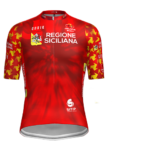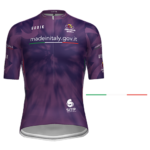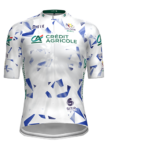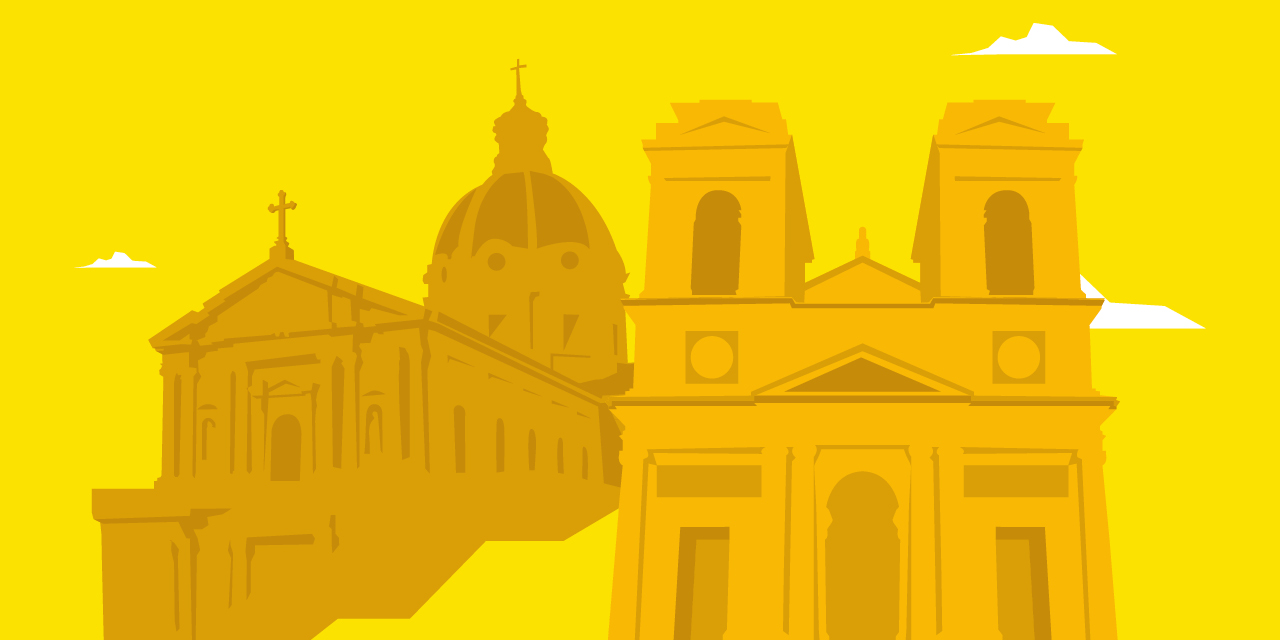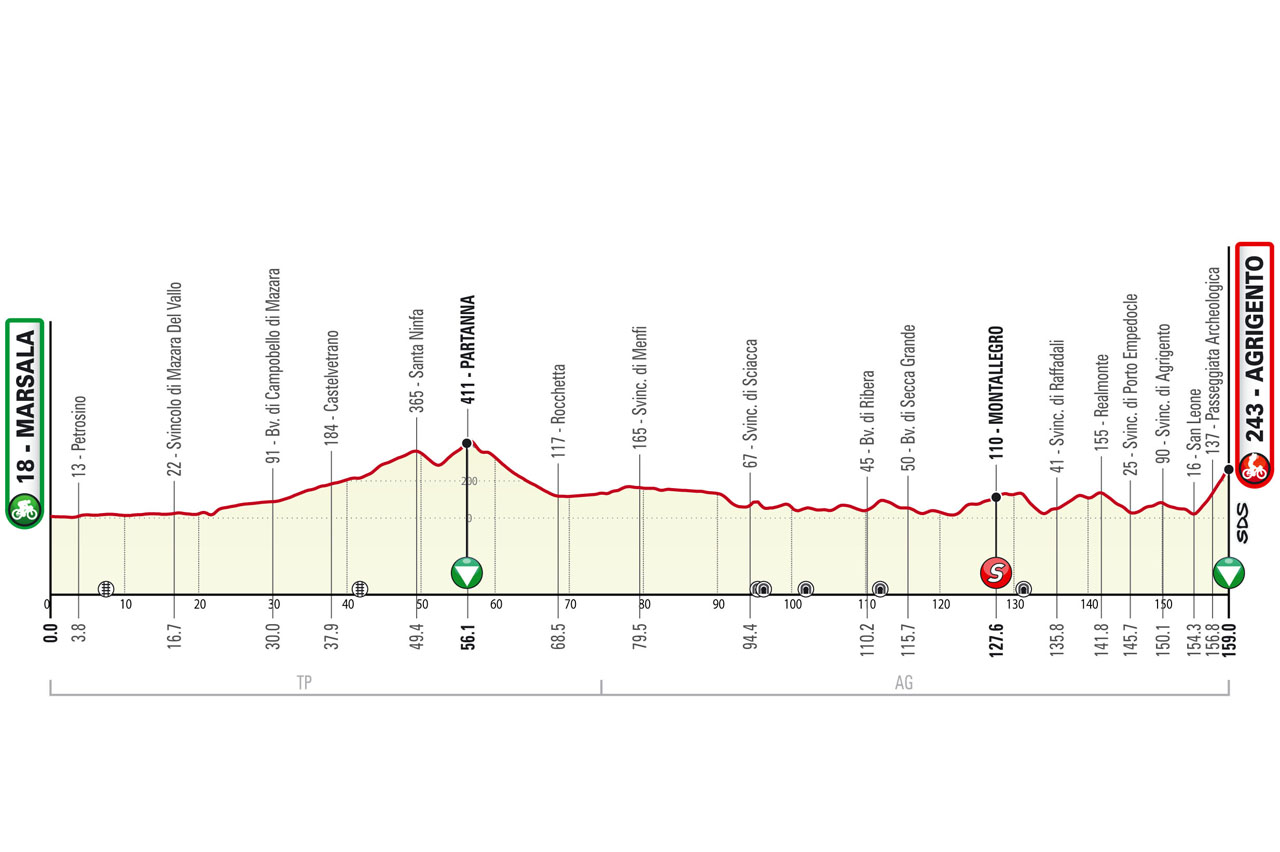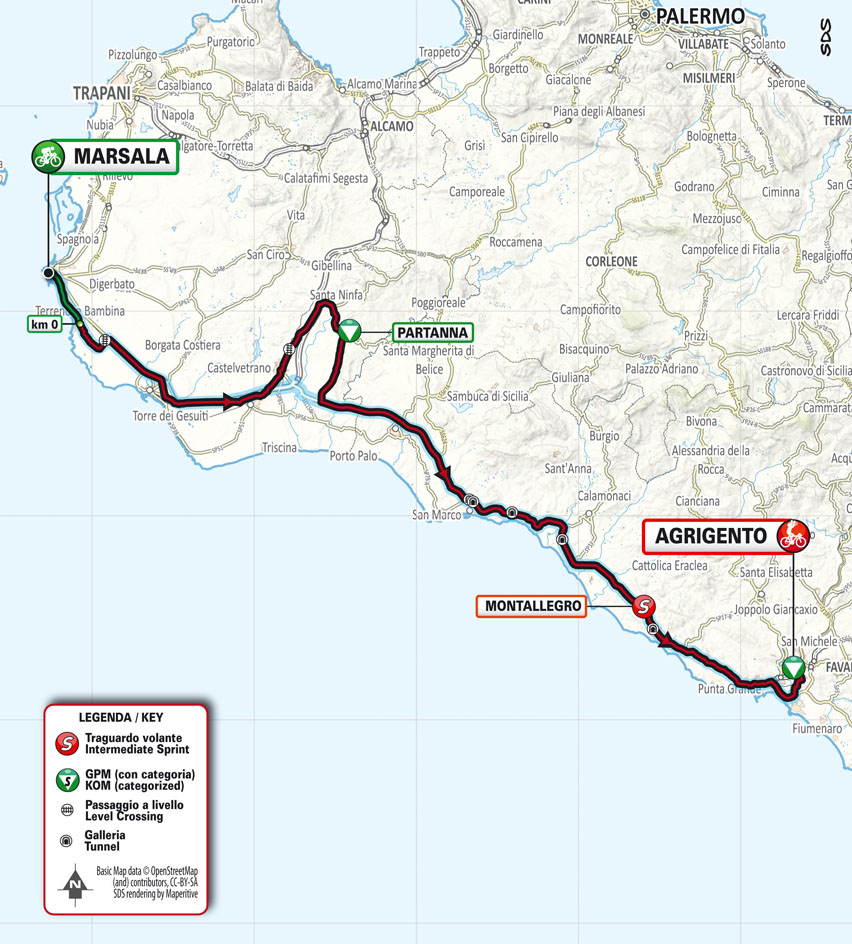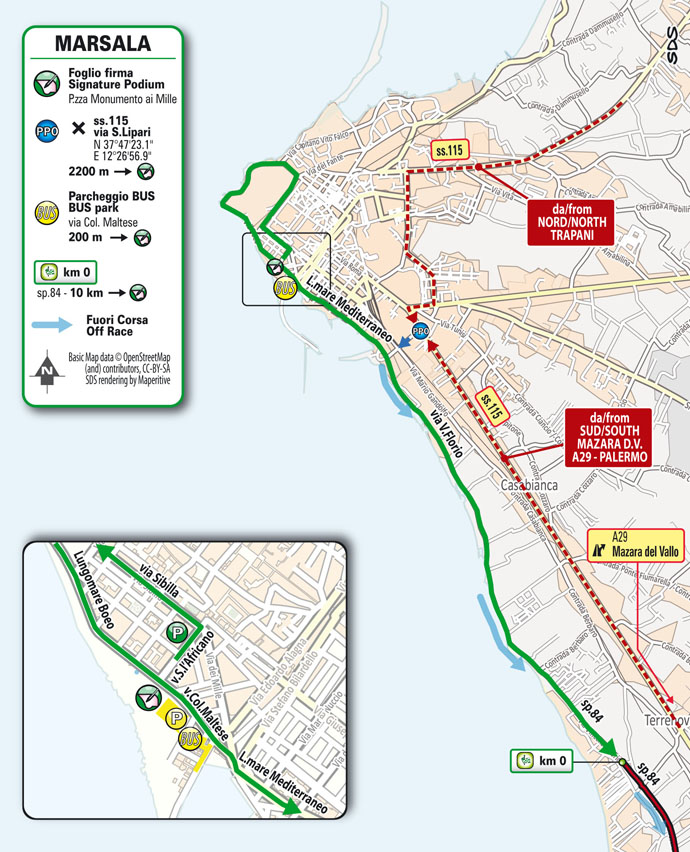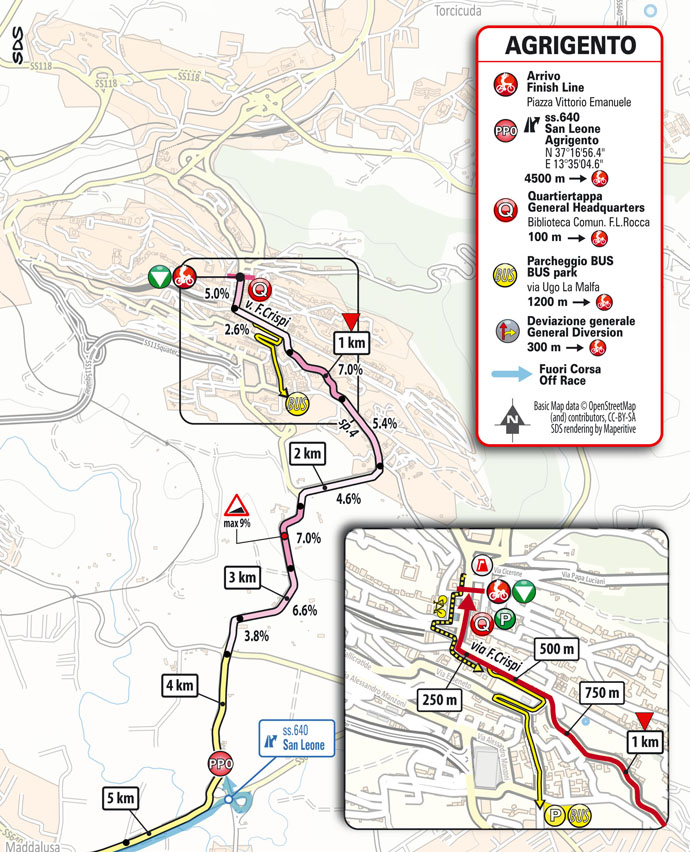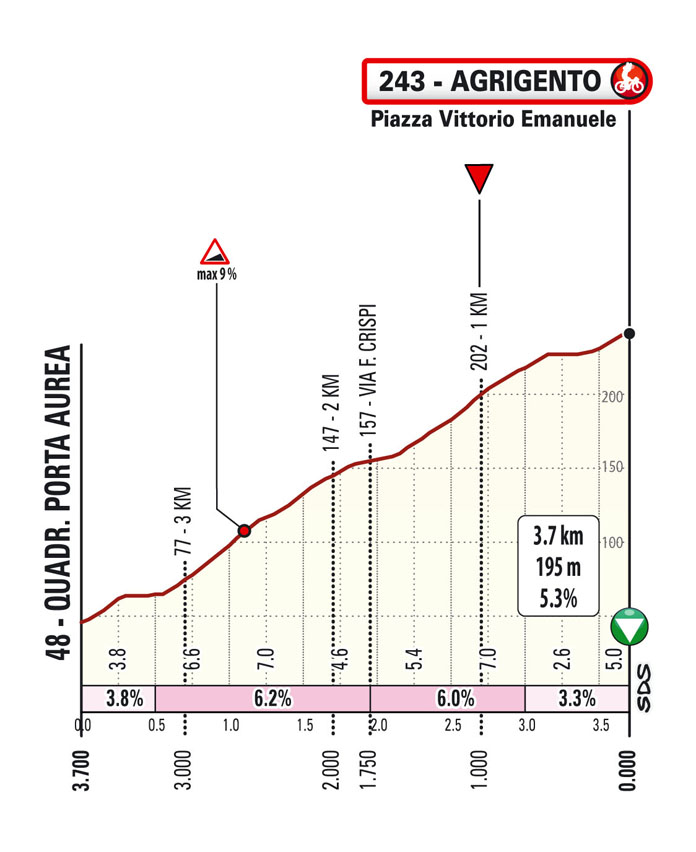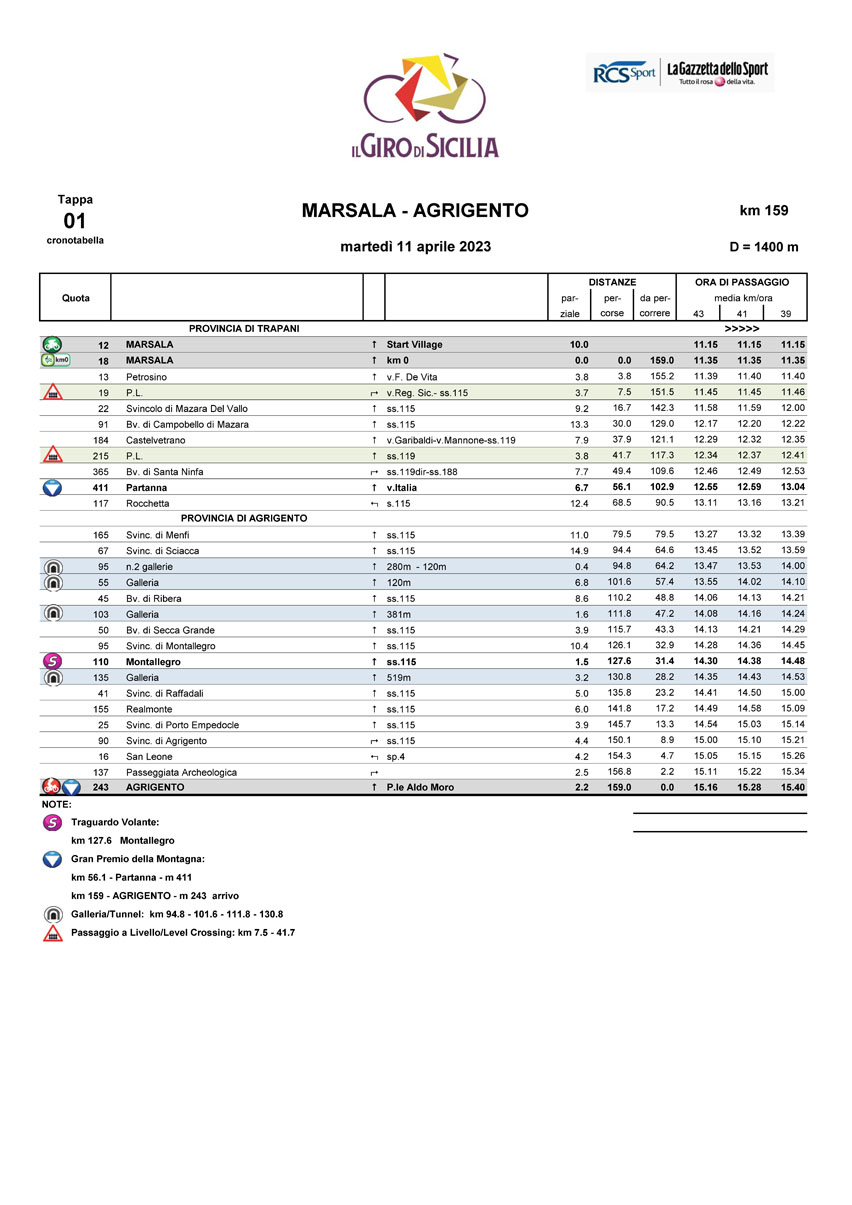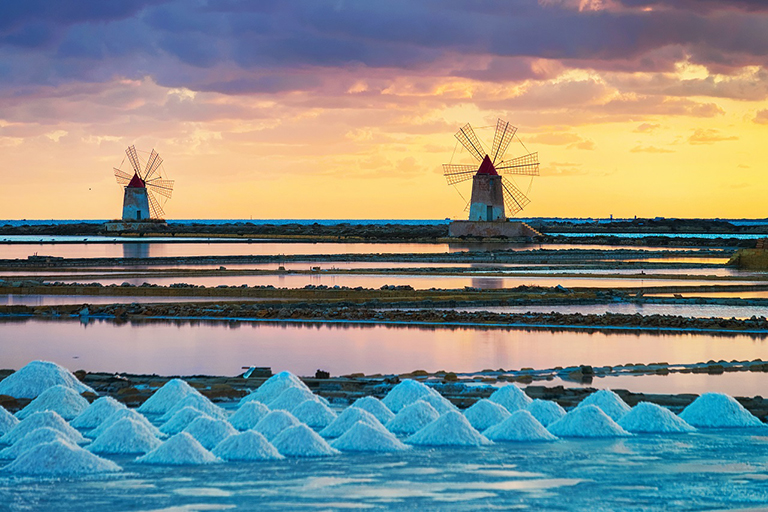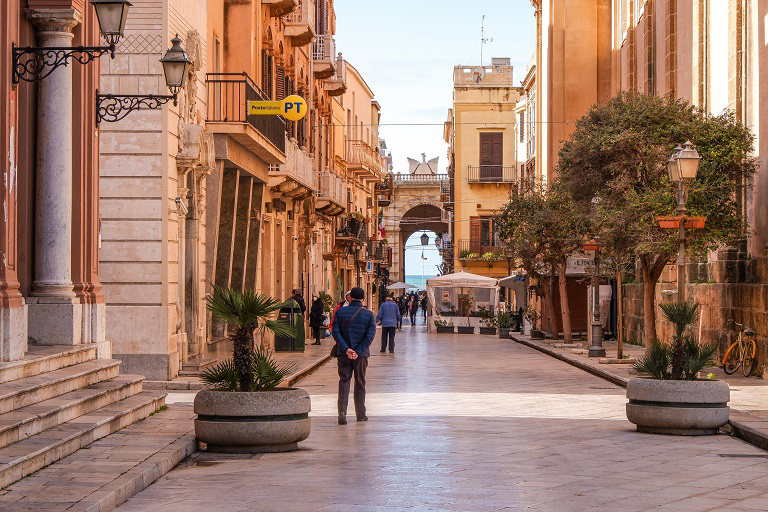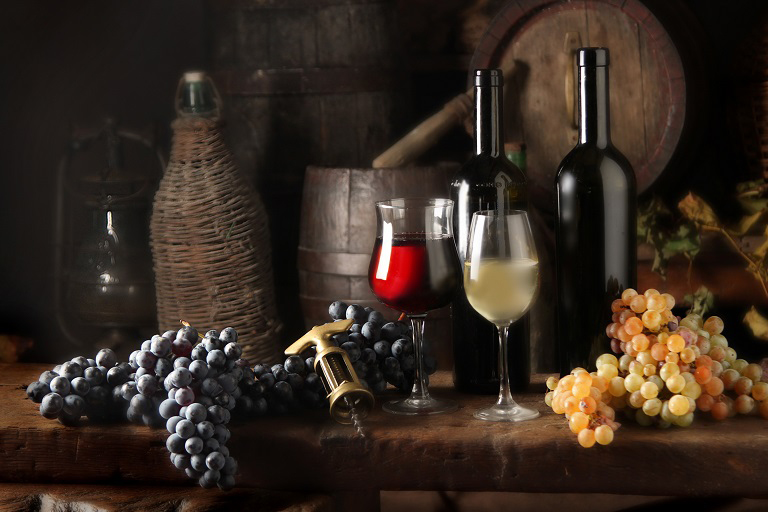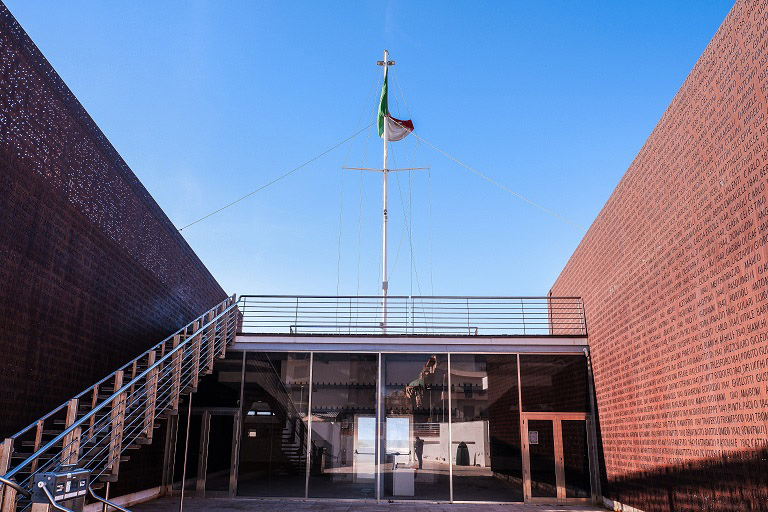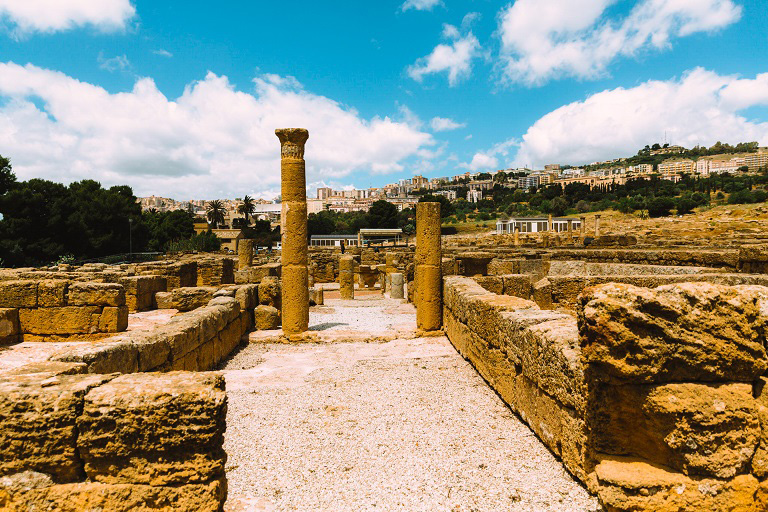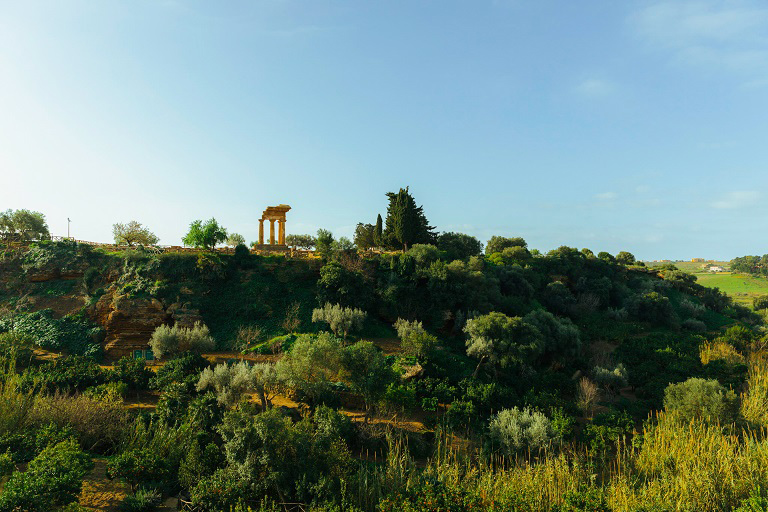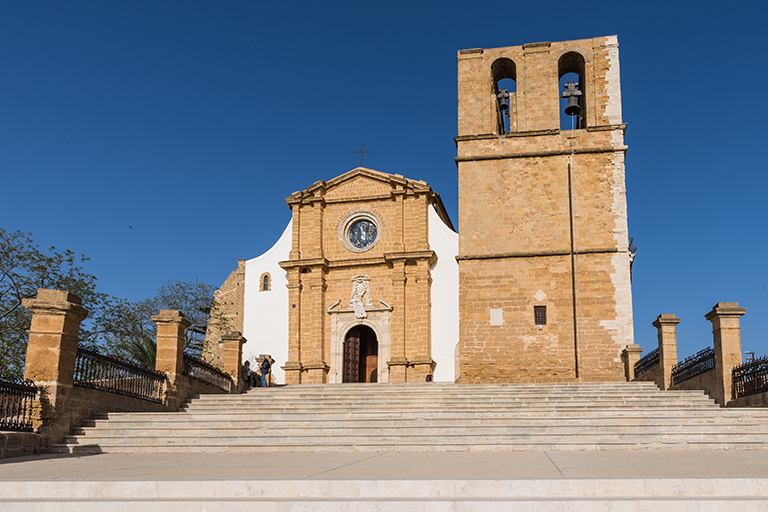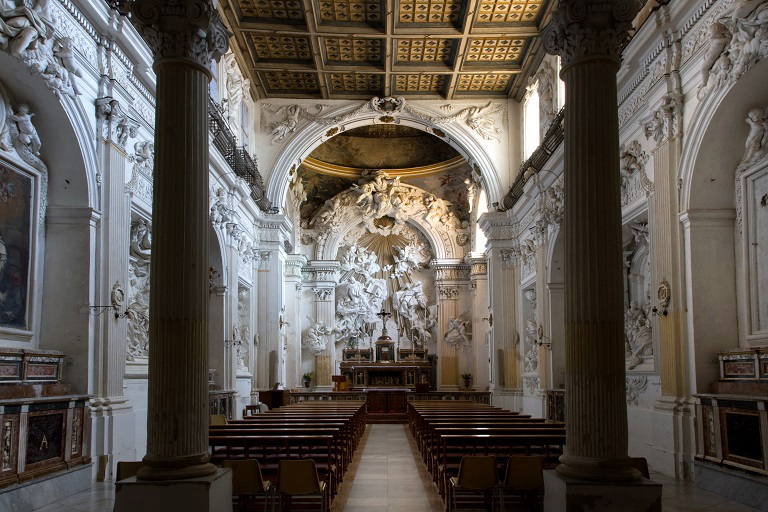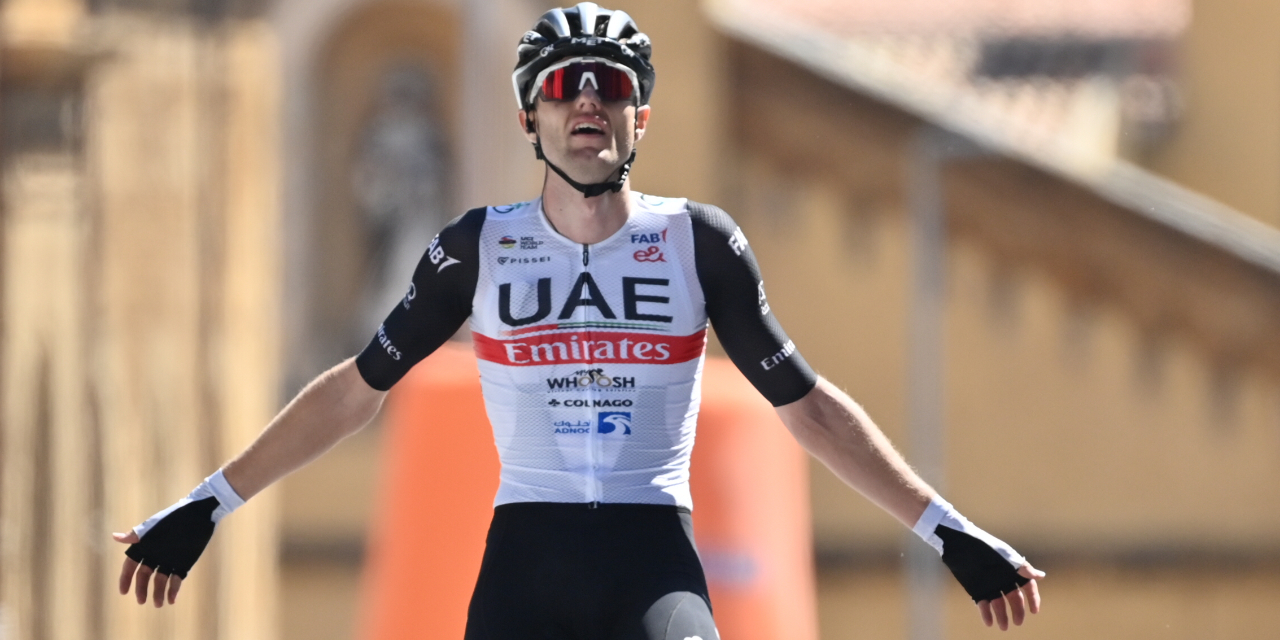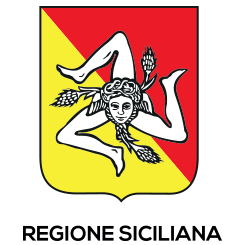learn more
technical info
profile
map
technical info
The stage is divided into two parts: the first one, through the hinterland around Trapani and the Valle del Belice, is intricate, wavy and rolling. The second part is mostly on fast roads, with no urban areas along the route. Past Marsala, the course undulates through Castelvetrano, Santa Ninfa and Partanna, and then takes the trunk road that will lead the peloton through some mild undulations to the Valley of the Temples, just outside Agrigento, 4 km before the finish.
Final kilometres
The final kilometres run entirely uphill at 5%, with peaks around 9% 2.5 km before the finish. The road is wide and well surfaced, with a succession of short straight stretches and mild bends. The home straight (250 m) is on 8 m wide tarmac.
start / finish
final kilometres
itinerary timetable
tourist info
Host city:
Marsala
Overview
Marsala is a place that needs to be slowly savoured. From its baroque historic centre to its salt pans and the island of Mozia, discovering it with slow sips leaves a pleasant aftertaste of … wine. It is located in the westernmost point of Sicily, in the province of Trapani, and is famous in Italian history for the Landing of the Thousand. Its historical centre is small and intimate, and you can explore it on foot in a couple of hours. On 11 May 1860, Giuseppe Garibaldi and the Thousand passed through Porta Garibaldi. Together with Porta Nuova, they are the two historic gates still visible in the city.
Food & Wine
But when talking about Marsala, one immediately thinks of the world-famous fortified wine DOP, one of Sicily’s most renowned wines. Its intense aroma with hints of vanilla, burnt honey and roasted hazelnuts goes well with delicacies such as cassateddi with dried figs and mustazzoli in vino cotto. Any advice on what to order at the restaurant? Don’t miss the couscous, the pasta with sardines (pasta c’anciova), the busiate pasta with tuna sauce: the fish here is extremely fresh!
Points of interest
From Piazza Matteotti to Porta Nuova, one “struscia” (“crawls”) along Via XI Maggio, called the Cassaro. Together with Via Garibaldi, it is one of Marsala’s main streets. The atmosphere is very suggestive, both in the morning and evening.
Along both sides of the street are souvenir shops, clothes shops, bars, bakeries and restaurants. You can enjoy shopping or stop to satisfy a sudden languor.
The elegant Piazza della Repubblica is the heart of the town. There stands the majestic Mother Church dedicated to St. Thomas of Canterbury. Its construction began in the Norman era, and the style of the Church is very recognisable, especially in the interior. The external façade is Baroque. Legend tells that a ship bound for England with a cargo of Corinthian columns had to land on the Sicilian coast because of a storm. That explains why the most important Church in the city is devoted to a Canterbury Saint.
Among the “minor” Churches is the Chiesa del Purgatorio, with its magnificent Baroque façade in two styles, and the Chiesa dell’Addolorata, whose construction is related to a miracle.
While strolling, majestic buildings such as Palazzo Burgio-Spanò catch the eye. And Palazzo Fici, one of the oldest and most prestigious buildings on Via XI Maggio, with its spectacular cobbled courtyard. The Palace is the symbol of “Marsala, City of Wine”, and it houses the Municipal Winery.
Behind the Mother Church, the small and interesting Museo degli Arazzi Fiamminghi houses a series of 16th-century tapestries depicting the gestures of Vespasian and his son Titus.
Near Porta Garibaldi, along the same name street, during the day is the fish market; in the evening, it becomes the centre of nightlife and entertainment, with several bars where you can drink and eat until late.
Leaving the old town from Porta Nuova, Villa Cavallotti is a strip of urban greenery that offers refreshment in summer. Its gardens end in a bastion. When you reach the seafront, where you can eat and relax in one of the many cafés, there is a magnificent view of the Egadi Islands. You can see the Monumento ai Mille (Monument to the Thousand), on which the names of the Thousand who landed at Marsala are written.
Continuing, you arrive at Capo Boeo, the extreme western tip of Sicily. There you will find the Museo Archeologico Regionale di Lilibeo Marsala – Baglio Anselmi. It is a former wine-making establishment, and part of the Archeological Park of Lilibeo, one of the three Archaeological Parks of Trapani. It houses the wreck of a Punic ship and here you can learn about the history of Lilybaeum (ancient Marsala).
Agrigento
Overview
As well as being one of the oldest Sicilian cities, it’s also remarkable for having risen again from the ashes several times. Its showpiece is undoubtedly the Valley of the Temples which, with its ties to the classical world, displays one of the city’s most fascinating sides, together with extraordinary finds housed in the Museo Archeologico Regionale.
The city, founded in 581 BC by Greek colonists from Rhodes and Crete, became Akràgas in the following century. In the past, it used to be one of the most magnificent centres in the Mediterranean. In 1997, UNESCO therefore placed the Archaeological Area of Agrigento on its list of world heritage sites.
The remains of Agrigentum include the of the villas of the nobility and the orderly streets of the Hellenistic/Roman Quarter.
Food
As you walk along the main street of Agrigento you can indulge in a little shopping in the boutiques and shops, not forgetting to try the famous gelato pecorino in the cafés and patisseries.
This is a delicately-flavoured ice cream made from sheep’s milk ricotta cheese. Its flavour is unique; it’s a genuine, little-known product typical of the Agrigento area.
Points of interest
The historic centre extends up the Colle di Girgenti hill; its main arteries are the Via Atenea and the nearby and panoramic Viale della Vittoria, with its views over the valley (Valley of the Temples) and the sea. After this, you enter the maze of small streets, based on an Arab plan, which connect the oldest monuments.
Let’s visit the Cattedrale di San Gerlando founded around the end of the 11th century by Bishop Gerlando. The cathedral is in Norman-Gothic style and is accessed by a wide, gentle staircase, flanked by a magnificent, unfinished 15th-century bell tower. The building houses the extremely precious Cathedral Treasury, which is particularly rich in works of art. You can climb the bell tower and admire the roofs of Girgenti from above. The cathedral’s historical archives contain a document as singular as it is mysterious: the letter of the devil, a 17th-century manuscript written in indecipherable characters and addressed to a nun, the Beata Corbera mentioned by Giuseppe Tomasi di Lampedusa in his novel, The Leopard.
The Cathedral is for this reason also one of the literary stops on the Strada degli Scrittori which will take you on an exploration of undiscovered Sicily!
The Via di Santa Maria dei Greci leads to the small church of the same name, in the oldest quarter of the medieval city. Built in the 12th century, its foundations rest on the base of a Doric temple from the 5th century BC which some believe to be that of Athena on the acropolis of Akràgas. The church, with a small, elegant courtyard before it, has a 13th-century Norman-Arab doorway in its façade and beautiful single-light windows.
A few minutes away, the Abbazia di Santo Spirito complex, built in 1260, is composed of the church and the adjacent Cistercian monastery. The internal ceiling bears the painted heraldic coat of arms of the Chiaramonte family, as the complex was actually founded thanks to a donation from wife of Federico Chiaramonte, Marchisia Prefoglio. The adjacent monastery (or Badia Grande) dates back to 1290, and is embellished with a magnificent cloister with outstanding Gothic doors. The nuns here prepare delicious almond and pistachio pastries, according to a centuries-old recipe. You absolutely must try them!
The Contrada San Nicola, just outside the urban centre, is where you’ll find the Museo Archeologico Regionale di Agrigento, with its panoramic view over the Valley of the Temples. It illustrates the history of ancient Agrigento and its territory, from prehistory until its Hellenisation. The highlight of its rich collection of archaeological finds is the more than 7 metres-high telamon, the Ephebus of Agrigento. Next to the museum, the medieval Chiesa di San Nicola houses the Phaedra sarcophagus, one of the greatest pieces of Roman sculpture in Sicily. Its lush garden is perfect for a break in the fresh air.
A visit to Agrigento cannot ignore the discovery of the Valley of the Temples. In an enchanted valley with flowering almond trees, there stands the most impressive monumental ensemble of Hellenic architecture in Sicily. In this mixture of man-made cultural environment and natural landscape lies all the charm of this UNESCO World Heritage Site.
This site is undoubtedly the most important vestige of ancient classical culture in Sicily. It comprises the temples of the gods, as well as the necropolis area and the extra-moenia sanctuaries. Inside the valley, not far from the temple of the Dioscuri, don’t miss the Giardino della Kolymbethra where you can breathe in the scent of the Mediterranean scrub. About 2,500 years ago, the tyrant Theron built a system of tunnels and hypogea designed to supply water to this small valley. The resulting large pool became a meeting place for the city’s inhabitants and provided entertainment for the rich. A century later it was buried and gave rise to a very fertile garden comparable, like a small garden of Eden.
This area is a precious example of Mediterranean scrub, and it’s full of citrus plants, pistachios, carob, walnuts, mulberries and pomegranates which still grow thanks to the ancient waterworks. This magical place is not infrequently the setting for events, concerts and exhibitions.
In the Caos district, a plateau overlooking the sea among olive trees and oaks houses the country house where Luigi Pirandello was born. The rooms, which look out over the countryside, house a vast collection of photographs, reviews and honours, first editions of books with autographed dedications, paintings of the author dedicated to him, and posters of the stagings of his most famous works in theatres around the world.






